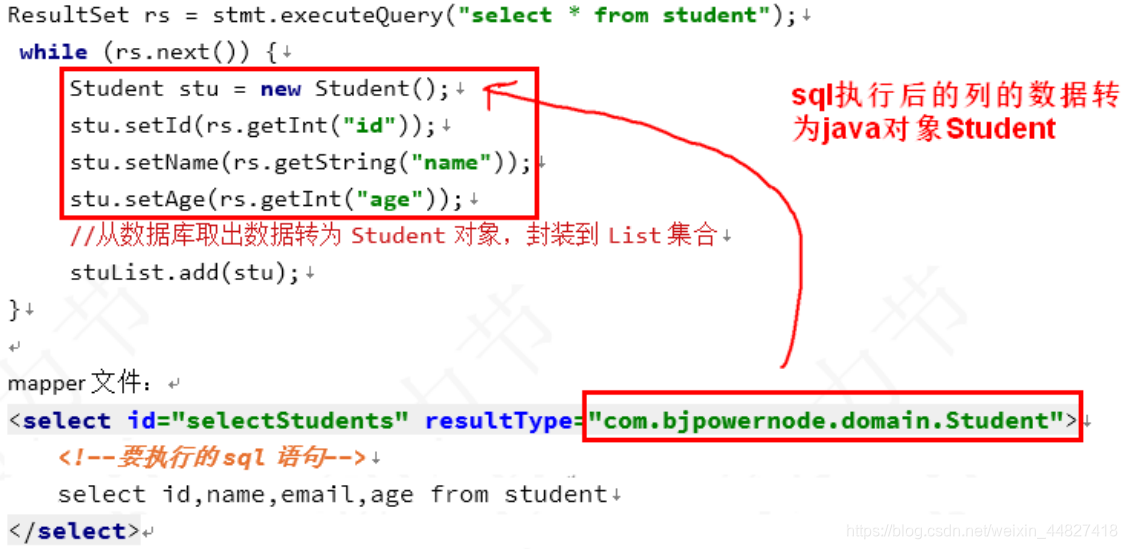1.1 resultType
resultType: 执行 sql 得到 ResultSet 转换的类型,使用类型的完全限定名或别名。
注意:如果返回的是集合,那应该设置为集合包含的类型,而不是集合本身。resultType 和 resultMap,不能同时使用。

A、简单类型
接口方法:
int countStudent();
mapper 文件:
<!--resultType简单类型-->
<select id="countStudent" resultType="int">
select count(*) from student
</select>
或者:
<!--resultType简单类型-->
<select id="countStudent" resultType="java.lang.Integer">
select count(*) from student
</select>
注意:resultType结果类型的它的值
- 类型的全限定名称
- 类型的别名, 例如 java.lang.Integer别名是int
测试文件:
@Test
public void testReturnInt(){
SqlSession sqlSession = MybatisUtils.getSqlSession();
StudentDao dao = sqlSession.getMapper(StudentDao.class); // 这句代码可以自动创建dao接口的实现类对象
int count = dao.countStudent();
System.out.println("学生总人数:"+ count);
}

B、 对象类型
接口方法:
public Student selectStudentById(@Param("studentId") Integer id);
mapper 文件:
<select id="selectStudentById" resultType="com.zep.domain.Student">
select id,name,email,age from student where id=#{studentId}
</select>
测试文件:
@Test
public void testSelectStudentById() {
/**
* 使用mybatis的动态代理机制,使用SqlSession.getMapper(dao接口)
* getMapper能够获取dao接口对应的实现类对象。
*/
SqlSession sqlSession = MybatisUtils.getSqlSession();
StudentDao dao = sqlSession.getMapper(StudentDao.class); // 这句代码可以自动创建dao接口的实现类对象
//调用dao的方法,执行数据库的操作
Student student = dao.selectStudentById(1001);
System.out.println("学生=" + student);
}


注意:Dao 接口方法返回是集合类型,需要指定集合中的类型,不是集合本身。

mybatis中也可以对我们自定义的类型起别名:
方法:
1)在mybatis主配置文件中定义,使<typeAlias>定义别名

<!--定义别名-->
<typeAliases>
<!--可以指定一个类型一个自定义别名
type:自定义类型的全限定名称
alis:别名(短小,容易记忆)
-->
<typeAlias type="com.zep.domain.Student" alias="stu"/>
<typeAlias type="com.zep.vo.ViewStudent" alias="vstu"/>
</typeAliases>
2)可以在resultType中使用自定义别名
接口方法:
public Student selectStudentById(@Param("studentId") Integer id);
mapper 文件:
<select id="selectStudentById" resultType="stu">
select id,name,email,age from student where id=#{studentId}
</select>
测试文件:
@Test
public void testSelectStudentById() {
/**
* 使用mybatis的动态代理机制,使用SqlSession.getMapper(dao接口)
* getMapper能够获取dao接口对应的实现类对象。
*/
SqlSession sqlSession = MybatisUtils.getSqlSession();
StudentDao dao = sqlSession.getMapper(StudentDao.class); // 这句代码可以自动创建dao接口的实现类对象
//调用dao的方法,执行数据库的操作
Student student = dao.selectStudentById(1001);
System.out.println("学生=" + student);
}

或者采用包扫描<package>:
1)在mybatis主配置文件中定义,使<package>定义别名

<typeAliases>
<!--
第一种方式:
可以指定一个类型一个自定义别名
type:自定义类型的全限定名称
alis:别名(短小,容易记忆)
-->
<!--<typeAlias type="com.zep.domain.Student" alias="stu"/>
<typeAlias type="com.zep.vo.ViewStudent" alias="vstu"/>-->
<!--
第二种方式
<package> name是包名,这个包中的所有类,类名就是别名(类名不区分大小写)
-->
<package name="com.zep.domain"/>
<package name="com.zep.vo"/>
</typeAliases>
2)可以在resultType的值中可以省略前面在<package>标签name属性中已经写过的内容,只需要写类名即可,类名就是别名。
mapper文件:
<select id="selectStudentById" resultType="Student">
select id,name,email,age from student where id=#{studentId}
</select>
测试文件:
@Test
public void testSelectStudentById() {
/**
* 使用mybatis的动态代理机制,使用SqlSession.getMapper(dao接口)
* getMapper能够获取dao接口对应的实现类对象。
*/
SqlSession sqlSession = MybatisUtils.getSqlSession();
StudentDao dao = sqlSession.getMapper(StudentDao.class); // 这句代码可以自动创建dao接口的实现类对象
//调用dao的方法,执行数据库的操作
Student student = dao.selectStudentById(1001);
System.out.println("学生=" + student);
}

C、 Map
sql 的查询结果作为 Map 的 key 和 value。推荐使用 Map<Object,Object>。
注意:Map 作为接口返回值,sql 语句的查询结果最多只能有一条记录。大于一条记录是错误。

接口方法:
//定义方法返回Map
Map<Object,Object> selectMapById(Integer id);
mapper 文件:
<!--
返回Map
1)列名是map的key,列值是map的value
2)只能最多返回一行记录。多于一行会报错
-->
<select id="selectMapById" resultType="map">
select id,name from student where id=#{stuid}
</select>
或者:
<select id="selectMapById" resultType="java.util.HashMap">
select id,name from student where id=#{stuid}
</select>
测试文件:
// 返回Map
@Test
public void testSelectMap() {
SqlSession sqlSession = MybatisUtils.getSqlSession();
StudentDao dao = sqlSession.getMapper(StudentDao.class); // 这句代码可以自动创建dao接口的实现类对象
//调用dao的方法,执行数据库的操作
Map<Object, Object> map = dao.selectMapById(1001);
System.out.println("m=" + map);
}

1.2 resultMap
resultMap 可以自定义 sql 的结果和 java 对象属性的映射关系。更灵活的把列值赋值给指定属性。
常用在列名和 java 对象属性名不一样的情况。
使用方式:
- 先定义 resultMap,指定列名和属性的对应关系。
- 在
<select>中把 resultType 替换为 resultMap。
注意:
resultMap和resultType不要一起用,二选一
接口方法:
/**
* 使用resultMap定义映射关系
*/
List<Student> selectAllStudents();
mapper文件:

<!--使用resultMap
1)先定义resultMap
2)在select标签中,使用resultMap来引用1中定义的。
-->
<!--定义resultMap
id:自定义名称,表示你定义的这个resultMap
type:java类型的全限定名称
-->
<resultMap id="studentMap" type="com.zep.domain.Student">
<!--定义列名和java属性的关系-->
<!--主键列,使用id标签
column:列名
property:java类型的属性名
-->
<id column="id" property="id"/>
<!--非主键列,使用result标签-->
<result column="name" property="name" />
<result column="email" property="email" />
<result column="age" property="age" />
</resultMap>
<select id="selectAllStudents" resultMap="studentMap">
select id,name,email,age from student
</select>
测试文件:
/**/
@Test
public void testSelectAllStudents() {
SqlSession sqlSession = MybatisUtils.getSqlSession();
StudentDao dao = sqlSession.getMapper(StudentDao.class);
List<Student> students = dao.selectAllStudents();
for (Student student : students) {
System.out.println("学生=" + student);
}
sqlSession.close();
}

列名和属性名不同的第一种解决方案:


在domain文件夹下新建MyStudent.java:
package com.zep.domain;
public class MyStudent {
private Integer stuid;
private String stuname;
private String stuemail;
private Integer stuage;
@Override
public String toString() {
return "MyStudent{" +
"stuid=" + stuid +
", stuname='" + stuname + '\'' +
", stuemail='" + stuemail + '\'' +
", stuage=" + stuage +
'}';
}
public Integer getStuid() {
return stuid;
}
public void setStuid(Integer stuid) {
this.stuid = stuid;
}
public String getStuname() {
return stuname;
}
public void setStuname(String stuname) {
this.stuname = stuname;
}
public String getStuemail() {
return stuemail;
}
public void setStuemail(String stuemail) {
this.stuemail = stuemail;
}
public Integer getStuage() {
return stuage;
}
public void setStuage(Integer stuage) {
this.stuage = stuage;
}
}
接口方法:
List<MyStudent> selectMyStudent();
mapper文件:
<resultMap id="myStudentMap" type="com.zep.domain.MyStudent">
<id column="id" property="stuid"/>
<!--非主键列,使用result标签-->
<result column="name" property="stuname" />
<result column="email" property="stuemail" />
<result column="age" property="stuage" />
</resultMap>
<!--列名和属性名不一样-->
<select id="selectMyStudent" resultMap="myStudentMap">
select id,name,email,age from student
</select>
测试文件:
/**/
@Test
public void testSelectMyStudent() {
SqlSession sqlSession = MybatisUtils.getSqlSession();
StudentDao dao = sqlSession.getMapper(StudentDao.class);
List<MyStudent> students = dao.selectMyStudent();
for (MyStudent student : students) {
System.out.println("学生=" + student);
}
sqlSession.close();
}

列名和属性名不同的第二种解决方案:
采用列别名的方式,给数据库的列名起一个别名,让这个别名和属性名相同即可!

接口方法:
List<MyStudent> selectDiffColProperty();
mapper文件:
<!--列名和属性名不一样:第二种方式
resultType的默认原则是 同名的列的值赋值给同名的属性,
所以使用列别名(java对象的属性名)即可解决
-->
<select id="selectDiffColProperty" resultType="com.zep.domain.MyStudent">
select id as stuid,name as stuname,email as stuemail ,age as stuage from student
</select>
测试文件:
@Test
public void testSelectDiffColProperty() {
SqlSession sqlSession = MybatisUtils.getSqlSession();
StudentDao dao = sqlSession.getMapper(StudentDao.class);
List<MyStudent> students = dao.selectDiffColProperty();
for (MyStudent student : students) {
System.out.println("###学生=" + student);
}
sqlSession.close();
}
